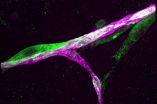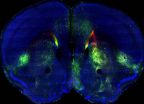(Press-News.org) NEW YORK, NY, February 27, 2014 — New research from Memorial Sloan Kettering provides fresh insight into the biologic mechanisms that individual cancer cells use to metastasize to the brain. Published in the February 27 issue of Cell, the study found that tumor cells that reach the brain — and successfully grow into new tumors — hug capillaries and express specific proteins that overcome the brain's natural defense against metastatic invasion.
Metastasis, the process that allows some cancer cells to break off from their tumor of origin and take root in a different tissue, is the most common reason people die from cancer. Metastatic brain tumors are ten times more common than primary brain cancers.
Yet most tumor cells die before they can take root in the brain, which is better protected than most organs against colonization by circulating tumor cells. To seed in the brain, a cancer cell must dislodge from its tumor of origin, enter the bloodstream, and cross densely packed blood vessels called the blood-brain barrier. Until now, little research has been done into how metastatic brain tumors develop, but previous mouse experiments that imaged metastatic breast cancer cells over time have shown that of those cancer cells that do make it to the brain, fewer than one in 1,000 survive.
"We didn't know why so many of these cells die," says Joan Massagué, PhD, Director of the Sloan Kettering Institute and senior author of the study. "What kills them? And how do occasional cells survive in this vulnerable state — sometimes hiding out in the brain for years — to eventually spawn new tumors? What keeps these rare cells alive and where do they hide?"
In the Cell study, Dr. Massagué, with Fellow Manuel Valiente, PhD, and other team members, found that in mouse models of breast and lung cancer — two tumor types that often spread to the brain — many cancer cells that enter the brain are killed by astrocytes. These killer cells, the most common type of brain cell, secrete a protein called Fas ligand.
When cancer cells encounter this protein, they are triggered to self-destruct. The exceptional cancer cells that escape the astrocytes do so by producing a protein called Serpin, which acts as a sort of antidote to the death signals fired at them by nearby astrocytes.
After imaging defiant metastatic cells in the brains of mice, researchers noticed that the cells that were able to survive grew on top of blood capillaries, each cell sticking closely to its vessel "like a panda bear hugging a tree trunk," Dr. Massagué says. They found that the tumor cells produce a protein that acts like Velcro to attach the cells to the outer wall of a blood vessel.
"This hugging is clearly essential," Dr. Massagué explains. "If a tumor cell detaches from its vessel, it gets killed by nearby astrocytes. By staying on, it gets nourished and protected, and may eventually start dividing to form a sheath around the vessel."
Under the microscope, the researchers watched these sheaths of cancer cells around the blood capillaries grow into tiny balls, which eventually became tumors. "Once you've seen it, you can never forget this image," Dr. Massagué says.
The tumor-cell survival factors uncovered by this study might one day be targeted with drugs to further diminish people's risk of metastasis. Dr. Massagué is particularly interested in the ability of tumor cells to hug blood vessels, as he suspects this behavior may be essential for the survival of metastatic cancer cells not only in the brain but also in other parts of the body where metastatic tumor growth can occur.
"Most cancer patients are actually at risk of having their tumor spread to multiple sites," Dr. Massagué notes. For example, breast cancers can metastasize to the bones, lungs, and liver, as well as to the brain. "What we may be looking at," he adds, "is a future way to prevent metastasis to many organs simultaneously" using drugs that make tumor cells let go of the blood vessels they cling to.
INFORMATION:
This work was supported by NIH grants P01-CA129243 and U54-163167, DOD Innovator award W81XWH-12-0074, and the Alan and Sandra Gerry Metastasis Research Initiative.
About Memorial Sloan Kettering Cancer Center
We are the world's oldest and largest private cancer center, home to more than 12,000 physicians, scientists, nurses, and staff united by a relentless dedication to conquering cancer. As an independent institution, we combine 130 years of research and clinical leadership with the freedom to provide highly individualized, exceptional care to each patient. And our always-evolving educational programs continue to train new leaders in the field, here and around the world. For more information, go to http://www.mskcc.org.
Study reveals mechanisms cancer cells use to establish metastatic brain tumors
2014-02-27
ELSE PRESS RELEASES FROM THIS DATE:
Methane leaks from palm oil wastewater are a climate concern, CU-Boulder study says
2014-02-27
In recent years, palm oil production has come under fire from environmentalists concerned about the deforestation of land in the tropics to make way for new palm plantations. Now there is a new reason to be concerned about palm oil's environmental impact, according to researchers at the University of Colorado Boulder.
An analysis published Feb. 26 in the journal Nature Climate Change shows that the wastewater produced during the processing of palm oil is a significant source of heat-trapping methane in the atmosphere. But the researchers also present a possible solution: ...
Famed Milwaukee County Zoo orangutan's death caused by strange infection
2014-02-27
MADISON – Mahal, the young orangutan who became a star of the Milwaukee County Zoo and an emblem of survival for a dwindling species, led an extraordinary life.
It turns out, the young ape died an extraordinary death, too.
Rejected by his biological mother at the Cheyenne Mountain Zoo in Colorado Springs, Colo., and eventually flown to Milwaukee aboard a private jet to live with a surrogate mother, Mahal became one of the Milwaukee County Zoo's star attractions. His unexpected death at age 5 in late December 2012 was a shock to the community that came to know him through ...
Scientists describe deadly immune 'storm' caused by emergent flu infections
2014-02-27
LA JOLLA, CA—February 26, 2014—Scientists at The Scripps Research Institute (TSRI) have mapped key elements of a severe immune overreaction—a "cytokine storm"—that can both sicken and kill patients who are infected with certain strains of flu virus.
Their findings, published in this week's online Early Edition of the Proceedings of the National Academy of Sciences, also clarify the workings of a potent new class of anti-inflammatory compounds that prevent this immune overreaction in animal models.
"We show that with this type of drug, we can quiet the storm enough to ...
Livestock found ganging up on pandas at the bamboo buffet
2014-02-27
VIDEO:
A panda in the Wolong Nature Reserve munches on bamboo -- which comprises 99 percent of the endangered species' diet in the wild.
Click here for more information.
Pandas, it turns out, aren't celebrating the Year of the Horse.
Livestock, particularly horses, have been identified as a significant threat to panda survival. The reason: They're beating the pandas to the bamboo buffet. A paper by Michigan State University panda habitat experts published in this week's Journal ...
Making treatment of rare blood disorder more affordable and effective
2014-02-27
PHILADELPHIA — A University of Pennsylvania research team has defined a possible new way to fight a disease that is currently treatable only with the most expensive drug available for sale in the United States. In a study published this month in Blood, the Penn team describes the strategy, based on the oldest part of the human immune system – called "complement" -- that could turn out to be less costly and more effective for the majority of patients with a rare blood disorder.
Complement is a network of more than 50 proteins in the blood and on cell surfaces that quietly ...
International study shows majority of children unaware of cigarette warning labels
2014-02-27
College Park, Md. -- An international study of children's perceptions of cigarette package warning labels found that the majority of children are unaware that they exist. Children in countries where larger warning labels are used, and which include a compelling graphic image of the negative health impacts of smoking, were more likely to be aware of and understand the health risks of tobacco products.
The study, led by Dina Borzekowski, Ed.D, in the University of Maryland School of Public Health (UMD SPH), and Joanna Cohen, PhD, Johns Hopkins Bloomberg School of Public ...
AGU: A 'shark's eye' view: Witnessing the life of a top predator
2014-02-27
HONOLULU – Instruments strapped onto and ingested by sharks are revealing novel insights into how one of the most feared and least understood ocean predators swims, eats and lives.
For the first time, researchers at the University of Hawaii and the University of Tokyo outfitted sharks with sophisticated sensors and video recorders to measure and see where they are going, how they are getting there, and what they are doing once they reach their destinations. (Go to http://www.youtube.com/watch?v=UHDOAmXRw-0&feature=youtu.be for video).
Scientists are also piloting ...
Mouse brain atlas maps neural networks to reveal how brain regions interact
2014-02-27
Different brain regions must communicate with each other to control complex thoughts and behaviors, but relatively little is known about how these areas organize into broad neuronal networks. In a study published by Cell Press February 27th in the journal Cell, researchers developed a mouse whole-brain atlas that reveals hundreds of neuronal pathways in a brain structure called the cerebral cortex. The online, open access, interactive image database, called the Mouse Connectome Project, provides an invaluable resource for researchers interested in studying the anatomy and ...
Study uncovers why autism is more common in males
2014-02-27
Males are at greater risk for neurodevelopmental disorders, such as autism spectrum disorder (ASD), than females, but the underlying reasons have been unclear. A large cohort study published by Cell Press on February 27th in the American Journal of Human Genetics provides compelling evidence in support of the "female protective model," which proposes that females require more extreme genetic mutations than do males to push them over the diagnostic threshold for neurodevelopmental disorders.
"This is the first study that convincingly demonstrates a difference at the molecular ...
Male goat essence really turns the females on
2014-02-27
Anyone who has ever spent time around goats knows they have a certain smell. By carefully analyzing eau de male goat, researchers reporting in the Cell Press journal Current Biology on February 27 have now identified a novel, citrus-scented ingredient that speaks directly to the females. It acts on female goats' brains to turn their reproductive systems on.
The study is the first to uncover a pheromone that activates the central reproductive axis, according to the researchers. Although the work was done in goats, the researchers say there is reason to think the findings ...




